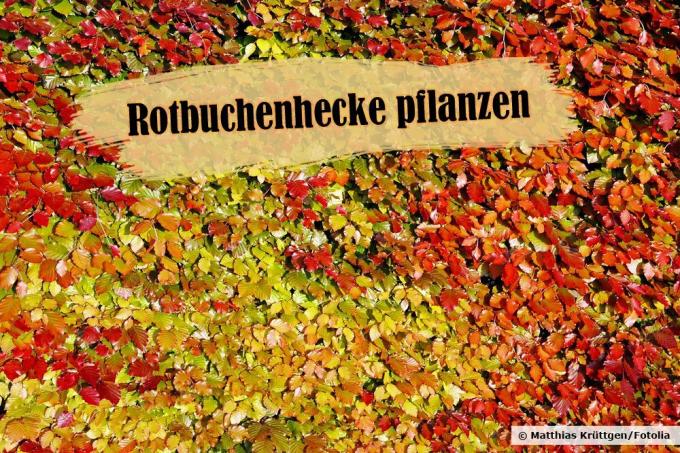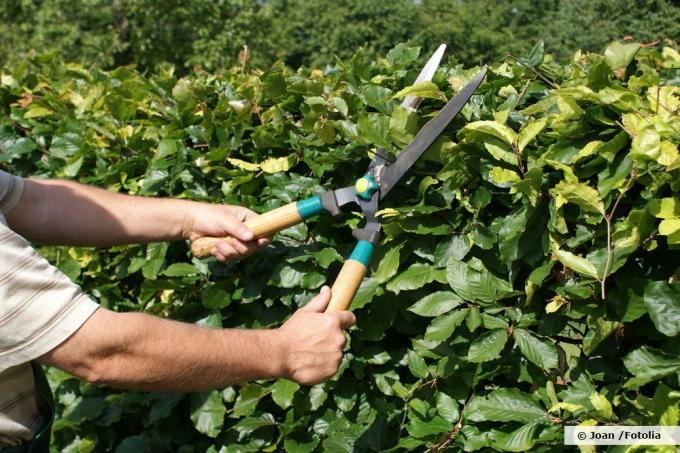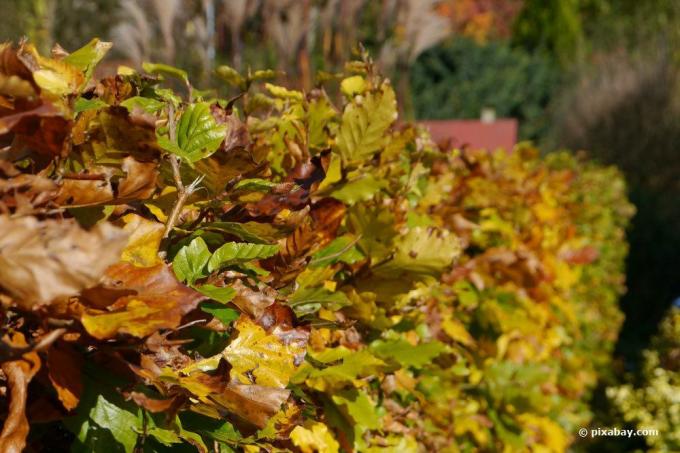
table of contents
- European beech hedge
- Location
- floor
- Plant selection
- Special varieties
- Planting time
- preparation
- Planting depth
- Plant spacing
- Insert plants
- care
- Cut
The common beech, botanically Fagus sylvatica, is native to all of Europe, where the climatic conditions are predominantly humid and cool. As the most common deciduous tree, it has a significant impact on the image of our forests in this country. No wonder that the common beech is one of the popular hedge plants, because it is perfectly adapted to our weather conditions. How and when to plant a beech hedge can be found in our detailed instructions.
European beech hedge
Location
A common beech is a fairly undemanding wood that grows both in light shade and in the sun. The leaves of the deciduous tree wear a shiny dark green over the summer and change their color from light yellow to orange-red in autumn. Where the wood feels comfortable, the dried leaves remain on the branches until they sprout again in spring. This makes them particularly attractive as a hedge.
floor
European beeches thrive best on humus-rich sandy and loamy soils that store moisture well. On the other hand, the subsoil must also be able to easily drain off the water, because the otherwise robust beech trees do not tolerate dryness and waterlogging.
- normal garden soils
- well permeable
- loamy
- fresh to moist
- medium rich in nutrients
- rich in humus
- pH value: slightly acidic to calcareous
Plant selection
who European beech as a hedge want to plant, can choose between seedlings, stem bushes and so-called heister in tree nurseries. Seedlings and Heister are usually offered bare-rooted. Since they dry out very quickly, they must be planted quickly after purchase. If that is not possible, they can also be put in a tub and watered regularly. However, this is only possible for a few days, because otherwise the European beech will be damaged.
- Seedlings: once transplanted, hardly branched young plants (low price)
- Heister: trees transplanted two or three times, better branched
- Stem bushes: several years old, more richly branched, mostly in containers or as bales
Fagus sylvatica trees are already very well developed and thus form a privacy screen very quickly, but these variants are also very expensive. Usually they are used for planting solitary trees. For very long hedges, heisters around 80 to 100 centimeters high are ideal. When buying, make sure that the plants are at least 60 centimeters high and that no injuries can be seen.

tip: Often the beech seedlings still look a bit sparse and modest when you buy them. However, if the trees are healthy, they will come out vigorously after planting.
Special varieties
Despite the addition of “red” in their name, red beeches have no red leaves. Those who prefer a red-leaved hedge should therefore choose copper beech (Fagus sylvatica 'Purpurea'). The leaves of this red beech variety shine wonderfully red as soon as they shoot.
Planting time
The right time is important so that a newly planted beech hedge can grow in well. Ideally, plant the hedge in the fall, before the first frosts. In this way, the trees still have the opportunity to develop before the winter dormancy. The beech trees have stopped growing above ground at this point, but root growth is still active at temperatures of at least seven degrees. The damp weather conditions in autumn also have a positive effect on the growth of the beech hedge. The rain closes any cavities and the roots get good contact with the garden soil. If you missed this date, you can plant container goods in the spring.
- ideal planting time: mid-September to the end of October
- in frost-free weather until early spring
- applies to bare-root plants and container plants
- alternative planting time for ball and pot plants: March to mid-May
- generally possible all year round
- only on windless, overcast days
preparation
Before the actual planting of the hedge plants, a few other measures must be observed so that the best conditions are given for easy growth.
1. Soil improvement measures
The soil should be well loosened before planting the beech hedge. Additional drainage is recommended for heavy substrates that tend to become waterlogged. In this case, mix the excavated earth with sand and humus or compost. In very sandy soils that do not hold moisture well, adding garden soil and compost is recommended. Also, remove any weeds, large stones, and old roots in the planting area.
2. Water trees
The young trees need a few days to grow into their new location. During this time there is still no intensive contact between the roots and the soil, so that they can only absorb a small amount of moisture from the soil. So that the hedge does not dry out, the trees must be watered generously again before planting. Ball plants and potted plants should be placed in a bucket or tub of water for about an hour before planting, until no more air bubbles appear.
Bare-root beeches
Bare-root Fagus sylvatica are often offered in tree nurseries. These variants should be planted in the garden soil without long storage times, otherwise the fine roots will dry out and die. However, these beeches must not stand in the water for more than about an hour.
tip: It is best to place bare-root beeches in a shady place and plant them as soon as possible.
Planting depth
To make the hedge look nice and straight, a cord is stretched over the entire length. Either individual planting holes can be dug or, better still, a planting trench can be dug. The trench has the advantage that it ensures better loosening of the garden soil. Be careful not to plant the trees too deep. The top layer of soil in the pot should be flush with the level of the soil. A common beech reacts quite strongly to earth heaps in the root area. Even ten centimeters of additional ground level can cause a beech hedge to die off for a long time.
- Planting hole: at least twice the depth and width of the root ball
- Plant trench: at least 50 cm deep and wide
- Planting depth: as before
- do not plant deeper or higher
- In the case of bare-rooted plants, all roots must be below the soil level
Plant spacing
Just as important as the correct planting depth is the right distance between the individual beeches so that the trees can grow healthy and vigorous. With a row planting, you can count on two to four plants per running meter. If you want a really tightly growing privacy and noise protection hedge, you can create a staggered double row.
- Plant spacing for simple row planting: about 25 to 30 cm
- Distance between double rows: 30 to 40 cm
- Trees per meter (double row): 4 to 7
Insert plants
First, the planting holes or the ditch may be filled with a layer of drainage material such as clay granulate or grit. Then put in the excavated material enriched with compost and loosely set up the individual plants at the correct distance. Finally fill up with the rest of the soil. Before you step on it with your foot, check the planting distance again and whether the beech hedge is straight. Corrections are still possible now. The best thing to do is to create a pouring rim straight away.
Note: Be sure to observe the applicable legal regulations for the minimum distance to neighboring properties. This mainly depends on the planned height of the hedge.
care
A red beech hedge does not need any special care measures. After planting, however, it is important to ensure that there is sufficient moisture in the soil so that the beeches can grow well. In longer dry periods it is therefore necessary to water regularly. It is also good for young trees if they are supplied with horn shavings or other organic long-term fertilizers in spring.
Cut
In a perfect location, beeches grow very strongly up to an age of 50 years. In height and width, the trees can easily grow between 40 and 70 centimeters per year. A real growth spurt can be observed especially between April and May. In order to limit the growth and to create a shapely hedge from the beech trees, the trees are ideally cut back twice a year. The first cut may be made when planting. At this point, however, you simply remove any dead or kinked branches to prevent pathogens from entering.
- Cut young plants only once a year (end of June)
- Cut new growth by half
- at first only cut side shoots
- later twice a year
- additionally in February
- cut about three quarters of the new shoots

Note: If you shorten the main shoot of young plants, the European beech will no longer be able to grow significantly in height. You should therefore wait with the cut in the upper area until the desired height has been reached.


